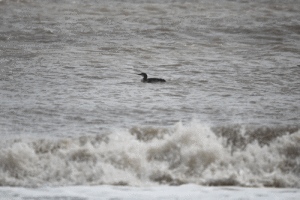Gulf Coast Bird Observatory is continuing to survey for non-breeding shorebirds along the Upper Texas Coast this season. Our current research intern, Kenlynn Volz, and I monitor Matagorda Beach, Bryan Beach, Quintana Beach, Surfside Beach, and Follet’s Island from the beginning of August to the end of March. Our target species are Piping Plover, Snowy Plover, Red Knot, Black Skimmer, and American Oystercatcher. Along with these species, we often come across other bird species as well. This past week while surveying on Matagorda Beach, we spotted a couple of Common Loons catching a ride in the gulf.
Common Loons are large diving waterbirds that migrate to the Upper Texas Coast during the winter. They can be found swimming along the gulf and hanging out in the bays as well. Common Loons have long bodies, short tails, round heads, and very large dagger-like bills. They are mainly known for their breeding plumage and are the symbols of summer in the Northeast.
During breeding season, they sport a bold black head and bill, thick black collar along with a semi-striped neck, and a striking black and white pattern on the back which contrasts with their red eyes. Sadly, we don’t get to see them here in Texas in their breeding plumage. We typically observe them in their winter plumage which is much duller. Their head and bill fade to gray with a little bit of black on top, their collars turn pale, their stripped throat becomes white, and their backs are grayer and whiter. But they are still amazing birds none of the less.

One of two Common Loon observed riding the waves near Matagorda Beach, TX.
Photo taken by Taylor Bennett on January 25th, 2022.
Common Loons spend most of their lives in the water and only come to land to breed, nest, or if they are hurt or sick. They mainly feed on live fish and catch their prey by diving, so they have various adaptations that make them master divers. Their disproportionately long feet and webbed toes allow them to push against the water, giving them the ultimate thrust. They have the ability to paddle their feet either in sync or alternatively allowing them to move in all directions even when they are under water.
Common Loons can change the buoyancy in their air sacs and can achieve neutral buoyancy by compressing their feathers and expelling air. They can also simultaneously extend and lower their neck and use their legs as propellers, allowing them to catch their fast-moving prey with ease.
